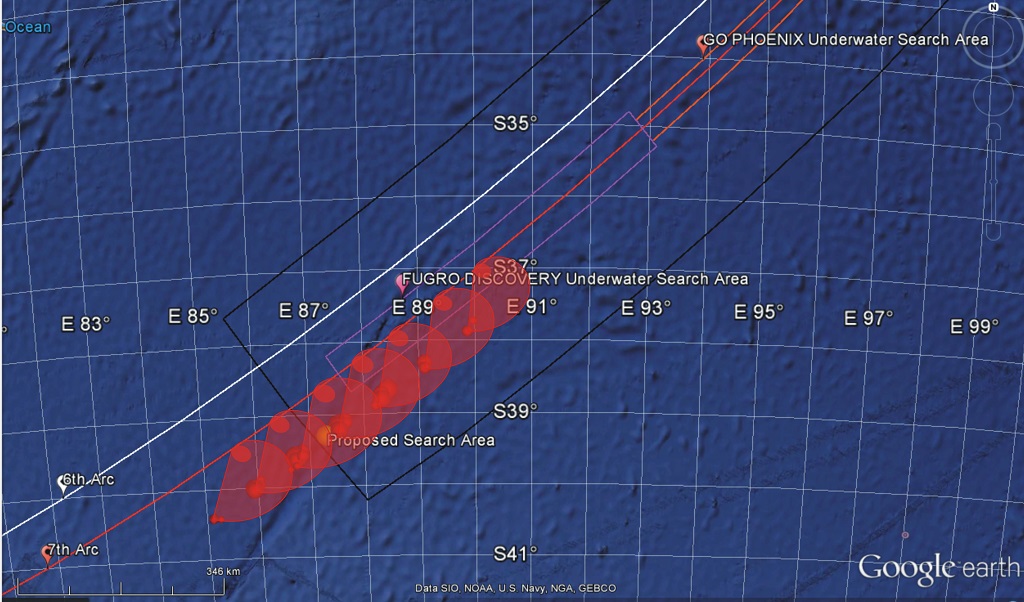Octavian Thor Pleter and Cristian Emil Constantinescu, and Barna Istvan Jakab, University Politehnica of Bucharest, 060042 Bucharest, Romania
Abstract: In the aftermath of the disappearance of the Malaysian 370 (MH370) flight in March 2014, new positioning methods were employed to establish the search area. In the absence of all other positioning technologies (Transponder, Radio communications, Radar), these innovative methods are based on the handshake signals between an INMARSAT satellite and the satellite transceiver on board the aircraft. The log of these signals was made public in order for the scientific community to engage in solving the mystery of the MH370 trajectory. The log indicates the delay between the interrogation and response signals, as well as the relative velocity indications, based on the shift of the carrier frequency due to the Doppler-Fizeau effect. This paper puts forward an original, independent and accurate positioning method and allows the calculation of the MH370 trajectory considering the wind vector field that day, the accurate satellite orbit and an accurate model of the Earth (the WGS-84 ellipsoid). The results were compared to other results published, indicating a different final position of the aircraft from the locations of the published search area.
Download full article here.
The article won the Richey Medal 2017 of the Royal Institute of Navigation, London.
Sesiunea de Comunicări Științifice Studențești 2024
Vă invităm să participați la „Sesiunea de Comunicări Științifice Studențești” care va avea loc pe 10 mai. Pentru a participa, este necesar să vă înscrieți până pe 18 aprilie, ora 14:00, prin trimiterea unui e-mail la adresa valentin.pana@upb.ro. Dacă aveți un profesor...
Acte lipsa ale studentilor masteranzi din anul II 2024
Acte lipsa ale studentilor masteranzi MA Acte lipsa ale studentilor masteranzi SHS Acte lipsa ale studentilor masteranzi PAPM Acte lipsa ale studentilor masteranzi GID
AeroConnectMeetings
În data de 2 martie 2024 a avut loc AeroConnectMeetings, un eveniment dedicat ingineriei Aerospațiale prin care studenții de la Facultatea de Ingnerie Aerospațială au avut posibilitatea de a...
Echivalarea modulelor PART66
<< Adresa FIA UPB mentinere creditare >> În urma demersului făcut către Autoritatea Aeronautică Civilă Română, şi a recunoaşterii conţinutului curicular la unele discipline predate la Facultatea de Inginerie Aerospaţială, UNSTPB, în raport cu...
<< Concurs pentru postul de director Departamentul de Ingineria Sistemelor Aeronautice și Management Aeronautic ”Nicolae Tipei” 2024-2029 >>
Depunerea dosarului pentru concursul de director de departament se va face pana la data de 21.02.2024, ora 16:00, la secretariatul departamentului. Sedinta de alegere a directorului de departament va avea loc in data de 27.02.2024, ora 14:00, la secretariatul...
<< Concurs pentru postul de director Departamentul de Grafica Inginereasca si Design Industrial 2024-2029 >>
Depunerea dosarului pentru concursul de director de departament se va face pana la data de 26.02.2024, ora 12:00, la secretariatul departamentului. Sedinta de alegere a directorului de departament va avea loc in data de 29.02.2024, ora 12:00,la sediul departamentului...
Concurs pentru postul de director Departamentul de Științe Aerospațiale ”Elie Carafoli” 2024-2029
Depunerea dosarului pentru concursul de director de departament se va face pana la data de 22.02.2024, ora 16:00, la secretariatul departamentului. Sedinta de alegere a directorului de departament va avea loc in data de 28.02.2024, ora 14:00, la secretariatul...
Premiul SESAR Young Scientist Award – Movilă George-Daniel
„În iulie 2023 am absolvit Facultatea de Inginerie Aerospațială la specializarea Echipamente și Instalații de Aviație, UPB. În același an, în noiembrie, am fost nominalizat la Single European Sky ATM Research (SESAR) Young Scientist Award (YSA), la care am concurat cu...
Metodologia privind organizarea și desfășurarea taberelor studențești 2024
Casa de Cultură a Studenților din București, instituție publică subordonată Ministerului Familiei, Tineretului și Egalității de Șanse vă transmite va pune la dispozitie documentația aferentă și metodologia privind organizarea și desfășurarea taberelor studențești 2023...
Cabinet de consiliere AeroPsi gratuit pentru studentii facultatii
Dragi studenți, In facultatea de Inginerie Aerospațială începând cu data de 11 decembrie 2023, funcționează "AeroPsi", un cabinet care vă va oferi servicii gratuite de consiliere, psihologie și psihoterapie. Serviciile sunt oferite de un psiholog atestat de Colegiul...


0 Comentarii